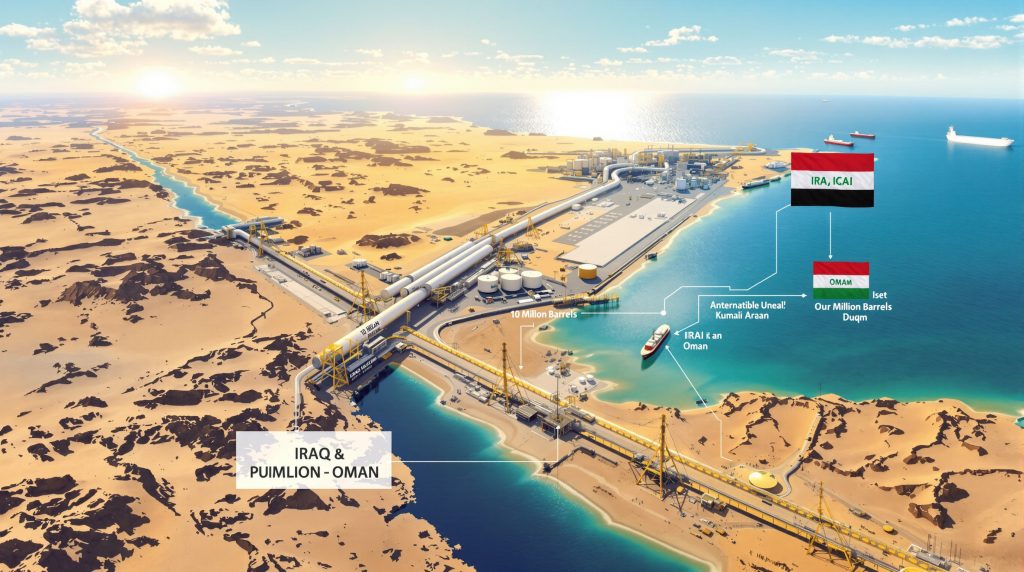What is the Iraq-Oman Oil Pipeline Deal?
The Iraq-Oman oil pipeline agreement represents a strategic partnership between Baghdad and Muscat aimed at creating a new export route for Iraqi crude oil. This preliminary agreement, reached in early 2025, outlines plans to construct a pipeline connecting Iraq's southern oil fields in Basra to Oman's rapidly developing port at Duqm. The deal includes significant oil storage facilities designed for long-term strategic flexibility and regional market access.
According to Ali Nazar al-Satari, general manager of Iraq's State Organization for Marketing of Oil (SOMO), the state oil marketer is actively engaged in discussions with Oman's OQ Trading to develop this critical infrastructure project. This represents a pivotal development in Middle Eastern energy infrastructure, potentially reshaping regional oil transport dynamics.
The pipeline would provide Iraq with a much-needed alternative export pathway that bypasses traditional maritime chokepoints, offering greater security and flexibility for one of the world's largest oil producers.
Technical Specifications and Economic Scale
Initial plans call for substantial storage capacity at the Omani end of the pipeline, allowing Iraq to better manage export flows and respond to market conditions. The infrastructure investment represents a significant commitment from both nations to develop stronger energy sector ties.
The project's strategic value extends beyond simple transportation, positioning both countries to benefit from changing global energy trade patterns and emerging market opportunities, particularly in Asia.
Why is Iraq Pursuing This Pipeline Project?
Reducing Dependence on Vulnerable Export Routes
Iraq's current oil export infrastructure faces significant vulnerabilities that have repeatedly disrupted the country's primary revenue source. The Kurdistan-Turkey pipeline, which previously transported approximately 450,000 barrels per day, has been offline since early 2023 due to ongoing political and legal disputes. These disruptions have cost Iraq billions in lost revenue and highlighted the risks of limited export options.
For a country where oil exports form the backbone of government finances, these vulnerabilities represent an existential economic risk that requires strategic diversification.
Strategic Diversification Beyond the Persian Gulf
Nearly 90% of Iraq's oil currently flows through terminals in the Persian Gulf, making the country vulnerable to regional tensions that could affect maritime shipping through the Strait of Hormuz. The proposed pipeline to Oman would provide a crucial alternative export route, allowing Iraq to maintain oil flows even during periods of heightened regional conflict.
This alternative route would offer unfettered sea access directly from the Gulf of Oman into the Arabian Sea, from which Iraqi oil can be transported eastward to Asian markets or westward toward African and European destinations without facing potential scrutiny or disruptions associated with the Persian Gulf shipping lanes.
Enhancing Iraq's Energy Security Posture
By establishing multiple export pathways, Iraq aims to strengthen its position as a reliable global oil supplier while reducing vulnerability to regional political pressures. This diversification strategy represents a long-term investment in national energy security rather than simply seeking the most economically efficient export solution.
For Iraq, which receives around 40% of its energy needs from neighboring countries, establishing sovereign control over export infrastructure has both economic and geopolitical significance. The Oman pipeline would give Baghdad greater leverage in regional energy politics while securing stable revenue flows.
How Will the Pipeline Be Constructed?
Potential Pipeline Routes Under Consideration
Two primary route options are being evaluated for the Iraq-Oman pipeline:
-
Overland Route: A land-based pipeline traversing through neighboring countries, potentially Kuwait and Saudi Arabia, which would require complex transit agreements and diplomatic coordination.
-
Undersea Pipeline: A submarine pipeline running through the Arabian Gulf, avoiding transit through other nations' territories but presenting significant technical challenges and higher construction costs.
Each option presents distinct advantages and challenges, with diplomatic, technical, and financial considerations influencing the final decision.
Technical and Logistical Challenges
The undersea route, while avoiding political complications of transit agreements, presents substantial engineering challenges. The pipeline would need to withstand harsh marine conditions while maintaining operational integrity across hundreds of kilometers of seabed.
Engineering challenges would be comparable to those faced in earlier regional pipeline projects. For perspective, a previously planned Iran-Oman gas pipeline was designed as a 192-kilometer, 36-inch pipeline running along the seabed of the Oman Sea at depths up to 1,340 meters. Similar technical considerations would apply to the Iraq-Oman oil pipeline.
Initial estimates suggest the project could take 3-5 years to complete once final approvals are secured, with extensive environmental studies and engineering assessments required before construction can begin.
Estimated Timeline and Investment Requirements
While specific investment figures haven't been publicly disclosed, energy infrastructure projects of similar scale typically require $5-10 billion in capital expenditure. The timeline for completion would likely extend into the late 2020s, with phased development of associated storage and port facilities.
Construction would likely begin with terminal facilities at both ends, followed by the gradual laying of pipeline sections, with the most technically challenging portions scheduled last to allow for proper testing and validation.
What Are the Economic Benefits for Both Countries?
Iraq's Export Diversification Strategy
For Iraq, the pipeline represents more than just infrastructure—it's a cornerstone of economic security. By establishing multiple export routes, Iraq can maintain steady oil revenues even when individual pathways face disruption. This stability is crucial for a country where oil exports account for approximately 90% of government revenue.
The ability to bypass potentially problematic shipping routes through the Persian Gulf would also provide Baghdad with greater market flexibility and potentially improved pricing for its crude oil market trends to Asian markets.
Oman's Port Development and Strategic Position
Oman stands to gain significantly by establishing Duqm as a major petroleum logistics hub. The country has invested billions in developing this deep-water port, and securing Iraqi oil flows would accelerate its transformation into a regional energy center. The deal aligns with Oman's economic diversification goals under its Vision 2040 program.
The strategic location of Duqm port offers significant advantages for international oil trade, providing direct access to major shipping lanes while avoiding potential chokepoints like the Strait of Hormuz. This positioning makes it an attractive transshipment point for regional and global energy flows.
Joint Marketing and Storage Opportunities
Beyond physical infrastructure, the agreement includes provisions for joint crude marketing initiatives and utilization of Oman's strategic storage facilities. These arrangements could enhance both countries' ability to optimize pricing and respond to market fluctuations, particularly for exports to Asian markets.
The storage capabilities would allow both nations to better manage supply timing to maximize revenue, holding oil when prices are unfavorable and releasing it when market conditions improve—a strategic advantage in the volatile global oil market.
How Does This Project Affect Regional Geopolitics?
Impact on Gulf Cooperation Council Dynamics
The Iraq-Oman oil pipeline deal represents a significant evolution in regional economic cooperation outside traditional Gulf Cooperation Council (GCC) frameworks. By directly connecting an OPEC founding member with a non-OPEC Gulf state, the project creates new economic interdependencies that could influence regional diplomatic alignments.
This bilateral energy partnership demonstrates how changing regional dynamics are creating new patterns of cooperation beyond traditional political blocs, with economic interests driving new relationships.
Changing Middle East Energy Transport Corridors
This pipeline would establish a new energy corridor that bypasses both the Persian Gulf and the Red Sea, potentially reducing the strategic importance of traditional maritime chokepoints. This shift could have long-term implications for naval security priorities in the region.
By creating an alternative export route that avoids the heavily monitored Persian Gulf shipping lanes, the pipeline offers greater flexibility for regional oil producers while potentially reducing the leverage of countries that control key maritime passages.
Potential Implications for Regional Energy Security
By creating additional export capacity outside the Persian Gulf, the pipeline contributes to overall energy security for both producers and consumers. Diversified export routes reduce the impact of localized disruptions on global energy markets, potentially moderating price volatility during regional crises.
The pipeline also addresses growing concerns about shipping security in the Persian Gulf and Red Sea, where recent years have seen increased tensions and occasional attacks on commercial vessels. An overland or undersea pipeline would be less vulnerable to these maritime security threats.
What Challenges Could Delay or Derail the Project?
Financing and Investment Hurdles
Securing the necessary investment for a multi-billion-dollar infrastructure project presents significant challenges, particularly given Iraq's fiscal constraints and competing priorities for capital expenditure. International financing partners will likely be required, adding complexity to the project structure.
The project would need to demonstrate clear economic viability to attract international investors, with long-term supply agreements and financing guarantees likely necessary to secure funding commitments.
Transit Rights and Diplomatic Negotiations
If an overland route is selected, negotiating transit rights through Kuwait and/or Saudi Arabia would require delicate diplomacy. Historical tensions between Iraq and Kuwait could complicate these discussions, potentially leading to delays or route modifications.
Transit fees, security arrangements, and legal frameworks would all need to be negotiated, requiring significant diplomatic effort from all parties involved. Recent US oil production decline and sanctions activities affecting the region add another layer of complexity to these negotiations.
Technical and Environmental Considerations
The undersea pipeline option presents substantial engineering challenges, including seabed stability, corrosion protection in marine environments, and environmental impact mitigation. These technical considerations could increase costs and extend the timeline for project completion.
Environmental impact assessments would need to address potential risks to marine ecosystems, with particular attention to sensitive coastal areas and fishing grounds that could be affected by construction or potential leaks.
How Might This Pipeline Affect Global Oil Markets?
Enhanced Supply Security for Asian Consumers
The pipeline would strengthen Iraq's ability to reliably supply Asian markets, particularly China and India, which have become increasingly important destinations for Middle Eastern crude. This enhanced supply security could strengthen Iraq's position as a preferred supplier to these growing economies.
The ability to bypass potential disruption points in traditional shipping routes would make Iraqi oil supplies more reliable, potentially commanding premium prices from buyers who value consistent delivery schedules.
Potential Impact on Regional Oil Pricing Mechanisms
New export infrastructure could influence regional price differentials by changing transportation costs and delivery timeframes. The ability to bypass the Persian Gulf might create opportunities for more competitive pricing of Iraqi crude in certain markets.
This could potentially affect benchmark prices for Middle Eastern crude grades, as new delivery options might require adjustments to existing pricing formulas that are currently tied to specific loading locations and transportation routes.
Long-term Implications for Global Energy Flows
As energy transition accelerates globally, strategic oil infrastructure investments like the Iraq-Oman pipeline reflect a calculation that petroleum will remain a critical commodity for decades to come, even as its share of the global energy mix gradually declines.
The project acknowledges the continuing importance of secure, flexible delivery systems for fossil fuels during a prolonged transition period where oil remains essential to the global economy despite growing renewable energy adoption.
What Are the Strategic Benefits for Iraq Beyond Export Diversification?
Strengthening Iraq's Position Within OPEC
More reliable export capabilities would enhance Iraq's ability to consistently meet production quotas and potentially strengthen its influence within OPEC. The country has historically struggled with export constraints that limited its ability to fully capitalize on its production potential.
With more flexible export options, Iraq could potentially negotiate for more favorable OPEC production impact quotas, as its ability to reliably deliver oil to market would be enhanced.
Reducing Vulnerability to Regional Conflicts
By establishing export routes that bypass potential conflict zones, Iraq could maintain critical oil revenues even during periods of regional instability. This economic resilience is essential for a country still rebuilding after decades of conflict and sanctions.
The reduced vulnerability to regional tensions would provide greater certainty for government budgeting and economic planning, potentially improving Iraq's sovereign credit rating and attractiveness to international investors.
Creating Leverage in Regional Negotiations
Multiple export options give Iraq greater negotiating leverage with transit countries and regional powers. The ability to redirect oil flows provides strategic flexibility that could strengthen Iraq's diplomatic position on various regional issues.
This enhanced energy independence could translate into greater political autonomy, reducing the ability of neighboring countries to exert pressure on Baghdad through control of vital export routes.
What Does This Deal Mean for Oman's Economic Future?
Advancing Oman's Logistics Hub Ambitions
The pipeline agreement accelerates Oman's vision of establishing Duqm as a major global logistics and industrial center. Securing steady flows of Iraqi crude would attract additional petroleum-related industries and services to the developing port complex.
The project would generate significant port fees, storage revenues, and related services income, creating a sustainable revenue stream to support Oman's economic diversification beyond its own oil production.
Diversifying Beyond Domestic Oil Production
With its own oil reserves projected to decline in coming decades, Oman is strategically positioning itself as a processing and transit hub for regional energy resources. This transition leverages Oman's geographic position and infrastructure investments to create sustainable economic activity beyond its domestic production capacity.
By establishing itself as a key node in regional energy flows, Oman secures a role in the broader petroleum economy that can outlast its own reserves, creating long-term economic value through logistics, processing, and trading activities.
Strengthening Ties with Major Asian Economies
By enhancing its role in Middle Eastern oil exports to Asia, Oman strengthens its economic and diplomatic relationships with major powers like China, Japan, and India. These relationships extend beyond energy to include potential investments in manufacturing, technology, and other sectors.
The growing importance of Asian markets for Middle Eastern oil makes these relationships increasingly strategic, with energy infrastructure serving as a foundation for broader economic partnerships across multiple sectors.
FAQ: Iraq-Oman Oil Pipeline
When is the Iraq-Oman pipeline expected to be operational?
While specific timelines remain tentative, industry analysts suggest the pipeline could become operational by 2028-2030, assuming construction begins within the next 12-18 months. The project timeline will depend significantly on the selected route and financing arrangements.
How much oil could the pipeline transport daily?
Initial capacity is expected to be approximately 1-1.5 million barrels per day, representing about one-third of Iraq's current production. The infrastructure would likely be designed to accommodate future expansion as Iraq's production capacity grows.
Will this pipeline replace Iraq's existing export routes?
No, the Oman pipeline is intended to complement rather than replace existing export infrastructure. Iraq will continue utilizing its Persian Gulf terminals and potentially restore northern export routes when political conditions permit.
How does this project compare to other regional pipeline initiatives?
Unlike some proposed regional pipelines that have remained conceptual for decades, the Iraq-Oman project appears to have stronger commercial fundamentals and clearer strategic benefits for both parties, potentially increasing its chances of implementation.
Regional Energy Security Implications
The Iraq-Oman pipeline represents a significant development in regional energy security architecture, creating new patterns of interdependence while reducing vulnerability to traditional chokepoints. By establishing a direct connection between Iraqi oil fields and Oman's strategic port facilities, both countries gain economic benefits while contributing to a more resilient regional energy system.
For regional consumers, particularly in Asia, the pipeline offers the prospect of more secure supply chains and potentially more stable pricing. For producers throughout the Middle East, it demonstrates how strategic infrastructure investments can enhance sovereignty and economic security in an evolving global energy landscape.
As global trade war oil impacts and trade war global impacts continue to shape energy markets during their gradual transition toward a more diverse mix of sources, projects like the Iraq-Oman oil pipeline deal highlight how traditional hydrocarbon producers are adapting their infrastructure and commercial strategies to maintain relevance and maximize the value of their resources in a changing world.
Looking for Investment Opportunities in the Changing Middle East Oil Landscape?
The Iraq-Oman pipeline project represents significant potential for growth in the region's energy sector, with new infrastructure creating opportunities for investors. Discover how to identify similar high-potential opportunities in the resources sector with Discovery Alert's proprietary Discovery IQ model, which delivers real-time notifications on significant ASX resource discoveries at https://discoveryalert.com.au/discoveries/.




